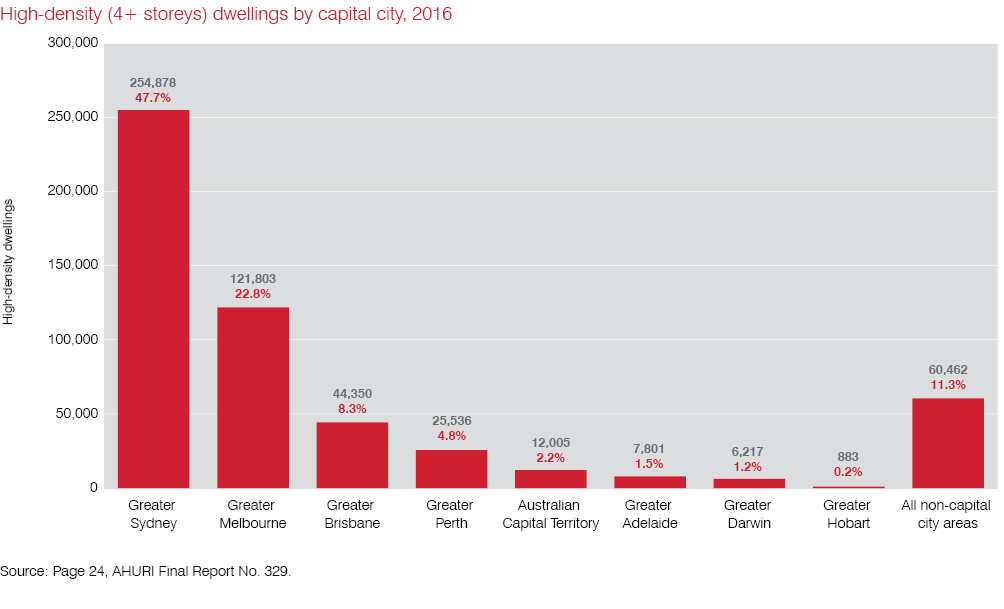
AHURI report finds that failure to address the needs of apartment residents risks the cohesion of our cities
Examining the needs of a rapidly increasing population of lower-income, high-density apartment residents
28 May 2020
In Australia, 10 per cent of the population lives in an apartment; 85 per cent of apartment residents live in capital cities; and 39 per cent of households living in high-density apartments are lower-income households. These lower-income households are disproportionally affected by challenges associated with apartment living, as they often have less choice and less control over their living situation.

Failure to address the needs of a rapidly increasing population of lower-income, high-density apartment residents risks undermining the prosperity and cohesion of Australian cities in future years, new AHURI research has revealed.
‘Lower-income apartment residents often have less choice and influence over the housing or location in which they live, and fewer resources available to respond to challenges that arise’
The research, ‘Improving outcomes for apartment residents and neighbourhoods’, undertaken for AHURI by researchers from UNSW Sydney, University of Sydney, RMIT University and Western Sydney University, examines the demographic characteristics of lower-income apartment residents in Australia and the types of buildings and neighbourhoods they live in.
‘Lower-income apartment residents often have less choice and influence over the housing or location in which they live, and fewer resources available to respond to challenges that arise’, says lead author of the report, Associate Professor Hazel Easthope from UNSW Sydney. ‘There is a lot of room for further innovation in the design, delivery and management of apartment buildings and neighbourhoods to improve quality of life for residents.’
The report finds it is especially important to provide good quality shared spaces. ‘Lower-income apartment residents often live in buildings with few shared spaces so the public shared spaces in their neighbourhoods are at risk of overuse. Having access to local community facilities and spaces—such as libraries, community centres, parks—is essential for apartment residents on lower incomes as they are less likely to be able to afford to use other commercial spaces such as cafes.’
Across the case studies, infrastructure to support redevelopment was delivered in a more timely way where government agencies were proactive in engaging with developers to coordinate the redevelopment.
The research found that, during large scale neighbourhood redevelopments, there are problems with relying on developer contributions to fund public infrastructure, as it means the timely completion of promised facilities can depend on the decisions of private companies. This highlights how decisions about funding models for public infrastructure can have ramifications for residents well beyond the individual development involved.
The research looked at four case studies of areas that have seen large-scale apartment development in Sydney and Melbourne and examined how these areas catered to the needs of lower-income residents. It found that one factor contributing to different outcomes was how well the urban redevelopment was coordinated by government agencies. Across the case studies, infrastructure to support redevelopment was delivered in a more timely way where government agencies were proactive in engaging with developers to coordinate the redevelopment.
The pressure on planning authorities to ensure developments are both publicly beneficial and privately profitable is challenging. While there was evidence of positive development outcomes, there was also evidence of speculative activity and inflated property values driving displacement, and developers overpaying for land then reducing quality to recoup costs.
On Thursday, 11 June 2020, AHURI will host an interactive Research Webinar exploring this research. Associate Professor Hazel Easthope and Dr Laura Crommelin from UNSW Sydney will present the research findings. The 90-minute webinar you will discuss the demographic make-up of lower income high-density apartment residents in Sydney and Melbourne, the five main points of tension in delivering high-density buildings and precincts that meet the needs of lower-income residents and what policy makers and developers can do to improve outcomes for lower income apartment residents.
To register for the event, please visit the event page on the AHURI website.
The final report is available at ahuri.edu.au/research/final-reports/329
